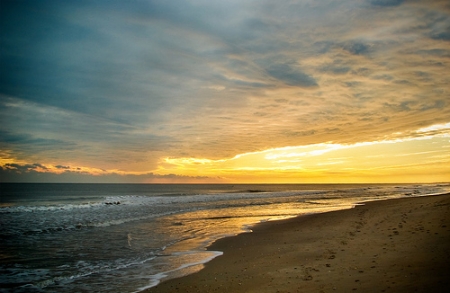While offshore wind power is a reality across much of the world, U.S. developments are in a race of sorts to see which project will be the first to hit the water in what could become one of the globe’s hottest markets.
“Right now we’re still waiting for some wet steel — the first project in water,” said Fara Courtney, executive director of the U.S. Offshore Wind Collaborative. “That’s an important marker for the industry.”
There are numerous plans in various stages, but they are mostly small demonstration-sized projects in Rhode Island, New Jersey, Ohio and beyond. The big one, though, has always been Cape Wind, a commercial-sized development that has received its permitting, and is now working on its financing. It’s the project that first got states thinking that they, too, may be able to tap into the East Coast’s vast wind resources.

While most of the conversation, and nearly all the action, has been centered in the Northeast and Mid-Atlantic states, the potential for offshore is gaining in the South in states like North Carolina.
The Tar Heel State is the southernmost Eastern state with a Renewable Portfolio Standard, but it has not done much in the way of wind developments.
That could all change, though, with Gov. Beverly Perdue’s executive order for a state task force that will explore the feasibility of turning the state’s offshore wind into an economic engine. The state explored legislation that could have paved the way to a significant pipeline of offshore development. That previous legislation did not pass. But this new task force takes a different approach. It will focus on the economic viability of offshore wind from various perspectives — such as energy costs, environment, manufacturing, jobs and tourism — before submitting a report to the state by March 31, 2012.
Brian O’Hara, president of the North Carolina Offshore Wind Coalition, expects that the report will find some factors favorable to investment in his state. The region has relatively low electricity prices, which have contributed to the stalling of many efforts to bring renewable energy to the region. What it does have is lots of wind.
According to NREL, North Carolina has the largest wind resource on the Atlantic coast. The state’s long coastline and wide continental shelf make it an ideal place to source wind. The steady and strong offshore wind resource that is usually found far out to sea exists in the relatively shallow waters off the North Carolina coast.
O’Hara says the prospects of creating an offshore manufacturing base would be a tremendous boost to his state, the region, and in turn, to an emerging industry. He cites the skilled labor force and low price of construction as two key reasons why some industry leaders have already begun exploring options in his state.
Courtney says that in order for the young industry to establish some roots, it is going to take partnerships, not only at the state level, but between states themselves.
The lack of a federal renewable portfolio standard has pushed the power into the hands of individual states. That, she says, is what is driving the process. As it matures, she sees regional partnerships taking the lead to foster a growing supply chain.
“There’s a lot happening in a lot of different places,” she said. “The industry needs to develop on a regional level because it needs to be at a market-scale to leverage investment to create manufacturing facilities. The states are going to compete with each other, which is also going to drive things, but they need to develop regional markets.”
Massachusetts, Rhode Island and Maine are already thinking on these terms. Maryland, Delaware and New Jersey are also natural partners.
North Carolina, meanwhile, isn’t standing alone in the South. Earlier this month, the state announced a partnership with South Carolina to explore ways to accelerate offshore wind partnerships.
“Our states are uniquely positioned with strengths and advantages that complement each other,” said Elizabeth Colbert-Busch of the Clemson University Restoration Institute.
It’s a natural alliance, says O’Hara. The region has a corner on the market for areas that are less than 30 feet deep and more than 12 nautical miles off shore. According to an NREL report, the two Carolinas have more than half of the resource. When you include Georgia and Virginia, more than 80 percent of that resource lies in the southern part of the East Coast.
While the partnership is currrently between the Carolinas, they say they are open to talking with neighboring states.
“This is a great first step in organizing the Southeastern states and working together towards some common goals,” said Hamilton Davis of the South Carolina Coastal Conservation League.
It’s these states that are relatively new to offshore development that have the most to gain from a project like Cape Wind, which needed 10 years to essentially get the green light to build.
“Cape Wind has given a more efficient, clear regulatory path,” said Courtney. “North Carolina is very interested in supply chain opportunities. The supply chain development is as important as the regulatory process. North Carolina will be watching closely at siting challenges and how those challenges are resolved. There are certainly things they’ll be able to take advantage of.”
Getting it in the right places, getting the number and types of jobs you want and getting electricity at prices you want will all be key factors as states and individual projects move forward. Winning public opinion is also a critical factor, something O’Hara says will be critical to gaining support.
“Tourism is very important,” he said. “We have to make sure we’re ensuring that we are not degrading that industry or that we are offshore enough so that the impacts are few.”
 Follow
Follow